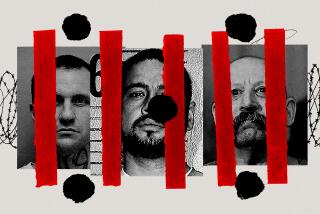Trial Begins in 1995 Slaying of Elderly Woman
A Ventura County prosecutor told a jury Monday that 39-year-old Kenneth McKinzie beat an elderly Oxnard woman to death three years ago and then stole the presents from under her Christmas tree.
In his opening statement, Donald Glynn described a crime committed by a junkie who wanted money for drugs and gifts for his children, a killer who he said confessed to murder while getting high on cocaine with a friend.
But defense attorney Willard Wikselltold the jury that prosecutors have accused the wrong man.
He said the real killer is a street tough named Donald Thomas, nicknamed âLittle Tommy,â who attacked 73-year-old Ruth Eloise Avrilin her garage and later sold her belongings to the defendant.
âThe evidence is going to show that someone else was there before Mr. McKinzie,â Wiksell said, telling jurors that his client will testify in his own defense. âHe did not kill Ruth Avril.â
The defenseâs theory was sharply attacked by the prosecution at an earlier hearing outside the juryâs presence. But Judge Vincent J. OâNeill Jr. ruled that Wiksell could tell the jury about another possible suspect.
McKinzie of Oxnard faces a possible death sentence if found guilty of murder and related charges, including robbery, carjacking and several counts of burglary.
The case has been slow to come to trial for a number of reasons, including the fact that it took police months to piece together the investigation.
The first break came more than a year after the Dec. 21, 1995, slaying when police received an anonymous tip that led them to McKinzie, whose former girlfriend lived next door to the victim.
He was arrested in Wasco State Prison, where he was serving a previous conviction, in March 1997, and the grand jury indicted him three months later. McKinzie has pleaded not guilty to the charges.
But prosecutors say they have a strong case against him, and Glynn outlined that case for the jury Monday.
He began by showing jurors a photograph of Avril taken before her death. She lived alone in an Oxnard triplex and had been divorced for 40 years. Then he showed the jury another picture of her lying dead in an irrigation ditch along Arnold Road.
Surfers Find Body
Avrilâs corpse was found the morning of Dec. 22, 1995, by two surfers on their way to a secluded surf spot near the Point Mugu naval base. She had been strangled and beaten. Wounds from 27 blows covered her head, neck, torso and limbs.
For nine days, authorities could not identify her body. Then a neighbor reported Avril missing and police made the link. When they searched her Dollie Street home, it had been ransacked.
Police found that stereo equipment and Avrilâs black Ford Taurus were missing, along with her driverâs license and ATM card. Further investigation showed that the card was used three times on the night she was killed to withdraw $440.
The car was later found abandoned behind the Oxnard Elks Lodge, and Avrilâs blood was smeared inside the trunk. Glynn said that based on the pattern of the smears, medical experts determined Avril was alive while pinned inside the trunk.
Glynn told the jury that the physical evidence is corroborated by the testimony of two key witnesses--Teresa Johnson and Ralph Gladney, who told police that McKinzie confessed to the killing.
Johnson will testify that on the night of the slaying McKinzie went to her Oxnard home and asked if she could help him use an ATM card to withdraw some cash, Glynn said.
She agreed, and went with the defendant to two nearby markets, where they withdrew $440 using that card, the prosecutor said. Using some of the stolen cash, McKinzie bought rock cocaine and went to Johnsonâs house to use it, Glynn said.
*
It was at that time, Glynn told the jury, that McKinzie confessed to Johnson.
âThe defendant said, âI think I killed someone, a nice lady who lived down the alley. I helped her carry her Christmas tree,â â Glynn said. âDuring his description of the events, he also told her he threw the body in a ditch, and we know that happened.â
The prosecutor said police matched stereo equipment and gifts taken from the defendant and his familyâs homes with serial numbers on boxes found inside Avrilâs apartment.
Specifically, he said, the prosecution will show McKinzie gave his daughter, Kenisha, two gifts that belonged to the victim, a quilted bathrobe and a camera.
When the film in it was developed, investigators found pictures of Avril.
Those findings will corroborate the testimony of Gladney, the prosecutionâs other key witness, Glynn said. Although he died in June, Gladney testified at a preliminary hearing last year and offered this statement: âHe said that he killed someone, a lady who lived on Dollie Street. He said he beat the lady up because it was Christmas and he needed money for his kids.â
While agreeing that such statements are compelling, Wiksell cautioned jurors in his opening statement to keep an open mind.
*
He described the prosecutionâs case as based entirely on circumstantial evidence, and said that a critical look at that evidence will show his client was nowhere near the murder scene.
Instead, he said, the defense will show that a handprint lifted from the stereo cabinet inside Avrilâs apartment belonged to Thomas, not McKinzie.
In brief detail, Wiksell explained the relationship between his client and Thomas. The pair knew each other on the street, he explained. Both lived in Oxnard. Both used drugs and occasionally used them together, he said.
On Dec. 22, 1995, McKinzie saw Thomas, who asked him if he wanted to buy some property, Wiksell said. Thomas also told McKinzie that he had some ATM cards, which McKinzie volunteered to use to get some money to buy some of the goods.
âHe figured the property was hot,â Wiksell said. âHe thought that was as far as it went.â
Wiksell admitted to the jury that his client illegally used Avrilâs ATM card, with Johnsonâs help, to withdraw $440 in cash. He said the defendant drove Avrilâs car to the markets, and took the money back to Thomas.
âIt was at that time,â Wiksell said, âhe learned the details of the murder.â
When McKinzie went back to Johnsonâs house, he was frightened and upset, acting agitated in a way he wasnât earlier in the night, Wiksell said.
âHe knew he was in the middle of a terrible situation,â he said.
Another Manâs Print
In concluding his remarks, Wiksell said there is no direct evidence--such as scratches on his clientâs body--to link him to the killing. He told the jury, âIf you look at this evidence critically, there isnât anything to connect Mr. McKinzie to the murder except property.â
Before Wiksell gave his opening statement Monday, Glynn objected to any mention of the handprint at the scene or McKinzieâs statements about Thomas, suggesting that they were not permissible under the law.
In a hearing outside the juryâs presence, Wiksell urged Judge OâNeill to allow him to mention Thomas and evidence connected to the defenseâs third-party theory.
Raising his voice, he reminded the court of the high stakes involved in the capital case and the dangers of keeping out evidence that could benefit his client.
âMr. McKinzie is entitled to a defense,â he said. âMaybe itâs true. Maybe it happened that way, then what do we do?â
After a short recess, OâNeill returned to the courtroom and ruled that Wiksell could discuss Thomas and the handprint during his opening statement.
Testimony is expected to continue today, and the trial is expected to last about a week.
More to Read
Sign up for Essential California
The most important California stories and recommendations in your inbox every morning.
You may occasionally receive promotional content from the Los Angeles Times.










